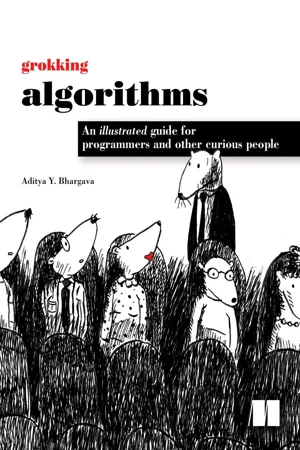
Grokking Algorithms
An illustrated guide for programmers and other curious people
- 256 pages
- English
- ePUB (mobile friendly)
- Available on iOS & Android
About this book
"This book does the impossible: it makes math fun and easy!" - Sander Rossel, COAS Software Systems Grokking Algorithms is a fully illustrated, friendly guide that teaches you how to apply common algorithms to the practical problems you face every day as a programmer. You'll start with sorting and searching and, as you build up your skills in thinking algorithmically, you'll tackle more complex concerns such as data compression and artificial intelligence. Each carefully presented example includes helpful diagrams and fully annotated code samples in Python. Learning about algorithms doesn't have to be boring! Get a sneak peek at the fun, illustrated, and friendly examples you'll find in Grokking Algorithms on Manning Publications' YouTube channel. Continue your journey into the world of algorithms with Algorithms in Motion, a practical, hands-on video course available exclusively at Manning.com (www.manning.com/livevideo/algorithms-?in-motion). Purchase of the print book includes a free eBook in PDF, Kindle, and ePub formats from Manning Publications. About the Technology An algorithm is nothing more than a step-by-step procedure for solving a problem. The algorithms you'll use most often as a programmer have already been discovered, tested, and proven. If you want to understand them but refuse to slog through dense multipage proofs, this is the book for you. This fully illustrated and engaging guide makes it easy to learn how to use the most important algorithms effectively in your own programs. About the Book Grokking Algorithms is a friendly take on this core computer science topic. In it, you'll learn how to apply common algorithms to the practical programming problems you face every day. You'll start with tasks like sorting and searching. As you build up your skills, you'll tackle more complex problems like data compression and artificial intelligence. Each carefully presented example includes helpful diagrams and fully annotated code samples in Python. By the end of this book, you will have mastered widely applicable algorithms as well as how and when to use them. What's Inside
- Covers search, sort, and graph algorithms
- Over 400 pictures with detailed walkthroughs
- Performance trade-offs between algorithms
- Python-based code samples
About the Reader This easy-to-read, picture-heavy introduction is suitable for self-taught programmers, engineers, or anyone who wants to brush up on algorithms. About the Author Aditya Bhargava is a Software Engineer with a dual background in Computer Science and Fine Arts. He blogs on programming at adit.io. Table of Contents
- Introduction to algorithms
- Selection sort
- Recursion
- Quicksort
- Hash tables
- Breadth-first search
- Dijkstra's algorithm
- Greedy algorithms
- Dynamic programming
- K-nearest neighbors
Frequently asked questions
- Essential is ideal for learners and professionals who enjoy exploring a wide range of subjects. Access the Essential Library with 800,000+ trusted titles and best-sellers across business, personal growth, and the humanities. Includes unlimited reading time and Standard Read Aloud voice.
- Complete: Perfect for advanced learners and researchers needing full, unrestricted access. Unlock 1.4M+ books across hundreds of subjects, including academic and specialized titles. The Complete Plan also includes advanced features like Premium Read Aloud and Research Assistant.
Please note we cannot support devices running on iOS 13 and Android 7 or earlier. Learn more about using the app.
Information
Table of contents
- Copyright
- Brief Table of Contents
- Table of Contents
- Preface
- Acknowledgments
- About this Book
- Chapter 1. Introduction to Algorithms
- Chapter 2. Selection Sort
- Chapter 3. Recursion
- Chapter 4. Quicksort
- Chapter 5. Hash Tables
- Chapter 6. Breadth-first Search
- Chapter 7. Dijkstra’s algorithm
- Chapter 8. Greedy algorithms
- Chapter 9. Dynamic programming
- Chapter 10. K-nearest neighbors
- Chapter 11. Where to go next
- Appendix. Answers to Exercises
- Index